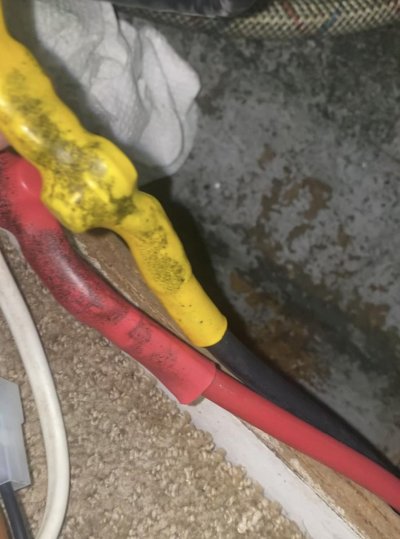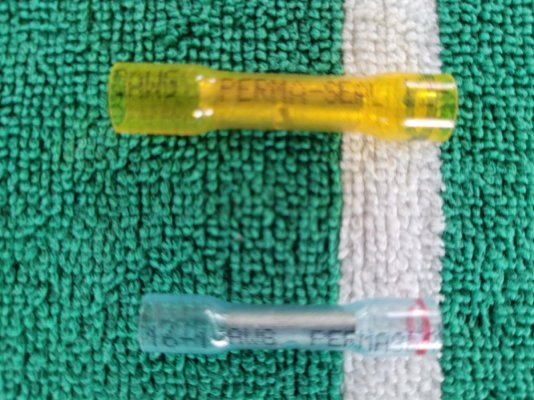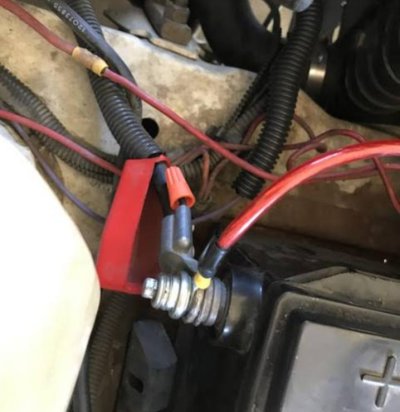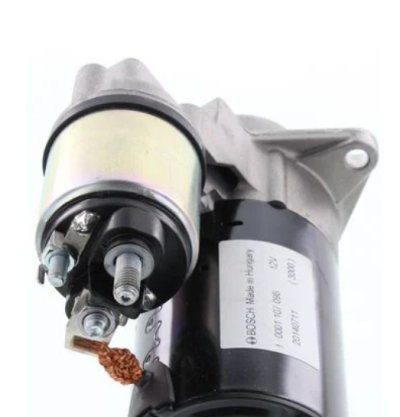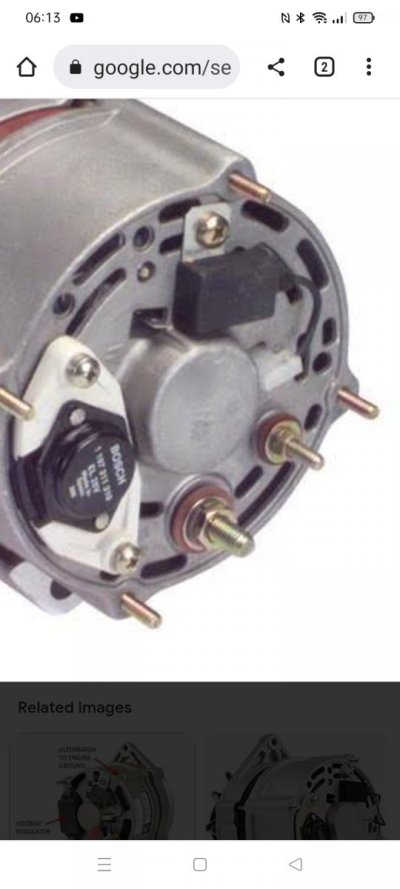You are using an out of date browser. It may not display this or other websites correctly.
You should upgrade or use an alternative browser.
You should upgrade or use an alternative browser.
Ring connectors - rookie question
- Thread starter ryastu
- Start date
The friendliest place on the web for anyone who enjoys boating.
If you have answers, please help by responding to the unanswered posts.
If you have answers, please help by responding to the unanswered posts.
Comodave
Moderator Emeritus
- Joined
- Jul 2, 2015
- Messages
- 22,417
- Location
- Au Gres, MI
- Vessel Name
- Black Dog
- Vessel Make
- Formula 41PC
I hope you don’t mean just bolting them together. For that a butt connector would be appropriate. If using ring connectors then something like a terminal strip would be good. Blue Sea makes quality electrical products. They have terminal strips good for 4 to 12 circuits. If you are using just one circuit then something like a power post would work but they are usually for high current circuits. Browse through their catalog for more ideas.
TowLou
Senior Member
As Comodave said. Best to attach by a bus bar if they have rings. Otherwise if you are not seperating then use a butt connector.
What guage wires? What does the wires feed? Is it a high amp draw like a windless?
What guage wires? What does the wires feed? Is it a high amp draw like a windless?
mvweebles
Guru
- Joined
- Mar 21, 2019
- Messages
- 7,759
- Location
- United States
- Vessel Name
- Weebles
- Vessel Make
- 1970 Willard 36 Trawler
Assuming smaller gauge wire, spend the extra money on heat shrink connectors. The heat shrink adds strength and waterproofness as well as electrical insulation. In my opinion, they should be the only crimp connectors aboard. (See attached picture).
A small heat gun works well and is small enough to keep in an electric kit.
https://www.amazon.com/dp/B08VFY8THD/ref=cm_sw_r_cp_awdb_imm_KXJBGREZ2P86P007H83Z
For larger diameter cable (8-awg and larger), butt connectors are a bit harder to come by and should be used sparingly because the added resistance in hi-current applications. Larger butt connectors come uninsulated and require separate heat shrink.
https://www.amazon.com/Splice-Conne...refix=2+gauge+butt+connectors,aps,182&sr=8-5#
Finally, these larger connectors and lugs require heavy crimping tool. A hydraulic crimper forms a much more consistent and secure crimp than plier-action, and certainly better than jaw-style that are struck with a hammer.
https://www.amazon.com/dp/B06XR8BY65/ref=cm_sw_r_cp_awdb_imm_R8QYH0W2R13V9AGFJED2
Hope this helps.
Peter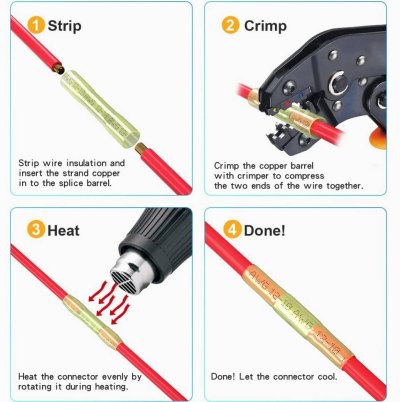
A small heat gun works well and is small enough to keep in an electric kit.
https://www.amazon.com/dp/B08VFY8THD/ref=cm_sw_r_cp_awdb_imm_KXJBGREZ2P86P007H83Z
For larger diameter cable (8-awg and larger), butt connectors are a bit harder to come by and should be used sparingly because the added resistance in hi-current applications. Larger butt connectors come uninsulated and require separate heat shrink.
https://www.amazon.com/Splice-Conne...refix=2+gauge+butt+connectors,aps,182&sr=8-5#
Finally, these larger connectors and lugs require heavy crimping tool. A hydraulic crimper forms a much more consistent and secure crimp than plier-action, and certainly better than jaw-style that are struck with a hammer.
https://www.amazon.com/dp/B06XR8BY65/ref=cm_sw_r_cp_awdb_imm_R8QYH0W2R13V9AGFJED2
Hope this helps.
Peter

Last edited:
RT Firefly
Enigma
Greetings,
Mr. r. In addition to the excellent advice already posted I would strongly suggest you invest in a good set of ratchet crimpers. Far superior to the cheapo crimpers you get with the "500 piece" connector kits you buy at Wally Mart.
Good:

Not so good:

I think even the entry level ratchet crimpers are superior to the second type pictured.
Mr. r. In addition to the excellent advice already posted I would strongly suggest you invest in a good set of ratchet crimpers. Far superior to the cheapo crimpers you get with the "500 piece" connector kits you buy at Wally Mart.
Good:
Not so good:
I think even the entry level ratchet crimpers are superior to the second type pictured.
The best conductor of electricity is silver, but I doubt you are going to find any nuts and washers made of it.
Brass nuts and washers are the best compromise of conductivity, strength and availability. But I often use SS because I have a bunch of these in various sizes and the surface area is relatively large and the distance is tiny, so the worse conductivity of SS hardly matters.
But I only use them to attach a spade connector to a screw terminal, never to attach two wires.
David
Brass nuts and washers are the best compromise of conductivity, strength and availability. But I often use SS because I have a bunch of these in various sizes and the surface area is relatively large and the distance is tiny, so the worse conductivity of SS hardly matters.
But I only use them to attach a spade connector to a screw terminal, never to attach two wires.
David
psneeld
Guru
if the rings are touching and the correct size for the wire...theoretically when placed together, little or no current should pass through the conductor.
Thus the reason for largest conductor on the bottom and no washer used on a battery terminal where several are stacked.
Thus the reason for largest conductor on the bottom and no washer used on a battery terminal where several are stacked.
Thanks for the replies. The context is as follows. Boat is new to me, as is DC electrical. I’m replacing the Tecma toilet controller(old one went out). This controller is the only piece of equipment on the circuit. Pretty large sized positive and ground wire from the breaker to the controler (photo attached) These wires had ring connector terminals installed on them. The new toilet controller wire is #14. My plan is/was to install ring connectors on the #14 positive and ground wires, and connect them to the incoming wires.
Based on some of the comments, maybe I’m not using the proper terminal types
I appreciate the responses and info. -Ryan
Based on some of the comments, maybe I’m not using the proper terminal types
I appreciate the responses and info. -Ryan
Attachments
O C Diver
Guru
- Joined
- Dec 16, 2010
- Messages
- 13,307
- Location
- Fort Myers, Florida
- Vessel Name
- End Of The Line
- Vessel Make
- Trinka 10 Dinghy
Comodave
Moderator Emeritus
- Joined
- Jul 2, 2015
- Messages
- 22,417
- Location
- Au Gres, MI
- Vessel Name
- Black Dog
- Vessel Make
- Formula 41PC
If the 2 wires you are connecting are fairly different in size then you shouldn’t use a butt connector. Unless you get some like Ted shows in his post. You should use a terminal strip and use ring connectors. Or a power post if you are only doing one connection. Something like Blue Seas 2010 Power Post. The terminal strip will let you do more than one connection. You should get a book on marine electrical work since you are new to electrical work. Also get some quality electrical tools, a stripper, a ratcheting crimper, heat gun and some wire cutters would be a good start. Buy only heat shrink adhesive lined connectors. Buy some adhesive lined heat shrink for the larger wires and cables.
Thanks, I appreciate the info! I do have a couple of Nigel Calder’s books. A lot to learn for sure!
Excellent, hopefully one is the Boatowner's Mechanical and Electrical Manual.
The go-to reference for every boat's library.
wkearney99
Guru
- Joined
- Feb 17, 2018
- Messages
- 2,189
- Location
- USA
- Vessel Name
- Solstice
- Vessel Make
- Grand Banks 47 Eastbay FB
Once you learn the proper techniques and have a few decent tools it's relatively easy to make proper wiring connections. A good ratcheting crimper and a way to do good heatshrinking are the two most important. I keep a Weller butane powered soldering iron on board for the purpose. Works great and is easily refillable. If I was going to be doing a lot of heatshrinking then I'd probably set up an extension cord and heat gun, but for just a few the butane unit works nicely. And just like any heat gun you do still need to mind that the end is going to stay hot for a bit, so be careful where you put it down.
GoneDiving
Guru
The best conductor of electricity is silver, but I doubt you are going to find any nuts and washers made of it.
Brass nuts and washers are the best compromise of conductivity, strength and availability. But I often use SS because I have a bunch of these in various sizes and the surface area is relatively large and the distance is tiny, so the worse conductivity of SS hardly matters.
But I only use them to attach a spade connector to a screw terminal, never to attach two wires.
David
Everything you say is true. However, lugs and connectors are designed to conduct through the mounting faces, not the bolts, washers etc. The bolts are there just to hold these faces together. This is especially true for high current applications like starters or bus bars. Always mount the connector directly on the mounting face. Never via washers, nuts etc. It's not uncommon to see a Christmas tree of connectors, nuts washers etc screwed on one long stud or bolt. It may work but voltage drop is substantial and the heat generated can be a real concern.
Attachments
Comodave
Moderator Emeritus
- Joined
- Jul 2, 2015
- Messages
- 22,417
- Location
- Au Gres, MI
- Vessel Name
- Black Dog
- Vessel Make
- Formula 41PC
Good photo of how not to do it. Just to clarify about washers, do not put them between any connections but it is ok to put one on top of the connectors under the nut or bolt head since current will not be flowing through the washer that way.
O C Diver
Guru
- Joined
- Dec 16, 2010
- Messages
- 13,307
- Location
- Fort Myers, Florida
- Vessel Name
- End Of The Line
- Vessel Make
- Trinka 10 Dinghy
Good photo of how not to do it. Just to clarify about washers, do not put them between any connections but it is ok to put one on top of the connectors under the nut or bolt head since current will not be flowing through the washer that way.
Lots of times that's not correct. Many times there is thread rod (often copper or brass) sticking through the case of a starter or solenoid. There is a nut on the thead rod, tight against the housing. Cables are stacked on the thread rod and a final nut holds the assembly tight. In these situations, current travels through both nuts to the thread rod.
On batteries lacking terminal posts with only a threaded hole, the manufacturer may assume current is traveling through both the face around the hole and the bolt connecting the cables to the battery. Many of these connections holes are no longer lead, requiring conductivity from both the bolt and hole faces.
Ted
GoneDiving
Guru
..... In these situations, current travels through both nuts to the thread rod.....
Ted
True, but the current flowing through face contact will be many times that of the connector to stud. Think about the tiny contact patch between the round hole and the sharp edge of the threads. Not to mention the oil, grease, paint and associated junk that find their way into these spaces. Same for the outermost nut: several more areas of added resistance compared to an innermost direct face to face contact.
Sure some studs do have fixed inner nuts but the majority of bus bars and high current uses the cable lug will be drawn down directly on a mating face, not sandwiched between two nuts, washers etc.
Attachments
O C Diver
Guru
- Joined
- Dec 16, 2010
- Messages
- 13,307
- Location
- Fort Myers, Florida
- Vessel Name
- End Of The Line
- Vessel Make
- Trinka 10 Dinghy
True, but the current flowing through face contact will be many times that of the connector to stud. Think about the tiny contact patch between the round hole and the sharp edge of the threads. Not to mention the oil, grease, paint and associated junk that find their way into these spaces. Same for the outermost nut: several more areas of added resistance compared to an innermost direct face to face contact.
You're mistaken. Contact area on threads of bolts and nuts isn't the "sharp edge", it's most of the back side of the thread. Depending on the number of threads engaged between the bolt and the battery socket (or nut), the electrical contact engagement may be greater with the threads than the bolt face.
Regarding "oil, grease, paint and associated junk", how is that any different on threads than face contact area? Do you mean to imply that you don't bother to clean battery terminal thread holes, bolts and associated terminals when assembling battery connections?
Ted
GoneDiving
Guru
You're mistaken. Contact area on threads of bolts and nuts isn't the "sharp edge", it's most of the back side of the thread. Depending on the number of threads engaged between the bolt and the battery socket (or nut), the electrical contact engagement may be greater with the threads than the bolt face.
Ted
I was talking about the direct path from the connector to the threaded stud. If you are talking about the circuitous route via the nuts washers etc then my comments about additional resistance at every contact point stands.
Perhaps I should of said that any direct face to face mating will have less resistance and more current capacity than going via numerous other fasteners etc.
Cheers
Comodave
Moderator Emeritus
- Joined
- Jul 2, 2015
- Messages
- 22,417
- Location
- Au Gres, MI
- Vessel Name
- Black Dog
- Vessel Make
- Formula 41PC
I was referring to putting a washer on top of the connectors before the nut that tightens down on the connectors.
GoneDiving
Guru
@gonediving #18:
The photo is unclear regarding the wire nut but, per ABYC Standards wire nuts are not compliant and we are permitted to stack no more than four terminations.
Thanks. Just for clarity, the photo was an example of what not to do.
I'm not American, so can't comment on ABYC standards. However, I'd suggest there are many issues there that wouldn't sit well with even the most backyard of mechanics.
Cheers
As others have said, connecting the ring terminals together using a fastener is less than ideal, and I'd add especially if heat shrunk because the tension of the fastener can't be checked. The alloy of the fastener is irrelevant because it is not in the current path.
A terminal strip would be preferred, or a butt splice, the former especially of the wire sizes are substantially different.
Ratcheting crimping tools are good for those who don't do this work often, they can be bulky and awkward in tight spots, under dashboards or behind electrical panels. A high quality conventional crimper, with plenty of leverage, that makes the crimp forward of the pivot point, is a viable alternative, especially for experienced electricians.
More here https://stevedmarineconsulting.com/crimping-etiquette/
A terminal strip would be preferred, or a butt splice, the former especially of the wire sizes are substantially different.
Ratcheting crimping tools are good for those who don't do this work often, they can be bulky and awkward in tight spots, under dashboards or behind electrical panels. A high quality conventional crimper, with plenty of leverage, that makes the crimp forward of the pivot point, is a viable alternative, especially for experienced electricians.
More here https://stevedmarineconsulting.com/crimping-etiquette/
rgano
Guru
- Joined
- Oct 8, 2007
- Messages
- 5,196
- Location
- Panama City area
- Vessel Name
- FROLIC
- Vessel Make
- Mainship 30 Pilot II since 2015. GB-42 1986-2015. Former Unlimited Tonnage Master
I just installed an EGT on my Yanmar, and the pigtail from the pyrometer came with a ring terminal, a nut and bolt, and a heat resistant sleeve. The instructions specifically stated that the connection to the boat's wiring should also be a ring terminal with a proscription against shifting to a butt connection. Only time I saw such.
Barking Sands
Guru
- Joined
- Dec 24, 2019
- Messages
- 991
- Location
- New Port Richey, Fl
- Vessel Name
- M/V Intrigue
- Vessel Make
- 1985 Tung Hwa Senator
I just installed an EGT on my Yanmar, and the pigtail from the pyrometer came with a ring terminal, a nut and bolt, and a heat resistant sleeve. The instructions specifically stated that the connection to the boat's wiring should also be a ring terminal with a proscription against shifting to a butt connection. Only time I saw such.
If its a thermocouple pyrometer (maybe type K) the very tip is probably one side alumel and the other chromel that generate its own signal. The leads and terminals are part of the sensor as a whole and critical. I have seen several aircraft come in with a malfunctioning engine and incorrect turbine temp only to find that someone "repaired" the terminals or extended the wiring...lol.
kapnd
Guru
- Joined
- Aug 31, 2013
- Messages
- 917
- Location
- usa
- Vessel Name
- #31
- Vessel Make
- ex-Navy MUB 50 fish/cruise
Connecting different sizes of wire begs deeper investigation into why the wires are not matched?
If the equipment comes with a larger wire than the supply line, you could be creating a problem, no matter how they are connected.
Hopefully that’s not the case!
If the equipment comes with a larger wire than the supply line, you could be creating a problem, no matter how they are connected.
Hopefully that’s not the case!
Similar threads
- Replies
- 8
- Views
- 1K
- Replies
- 17
- Views
- 2K
- Replies
- 18
- Views
- 1K
- Replies
- 8
- Views
- 741
- Replies
- 11
- Views
- 887

